MAZDA MX5 MIATA 2017 Owner's Guide
Manufacturer: MAZDA, Model Year: 2017, Model line: MX5 MIATA, Model: MAZDA MX5 MIATA 2017Pages: 568, PDF Size: 16.58 MB
Page 31 of 568
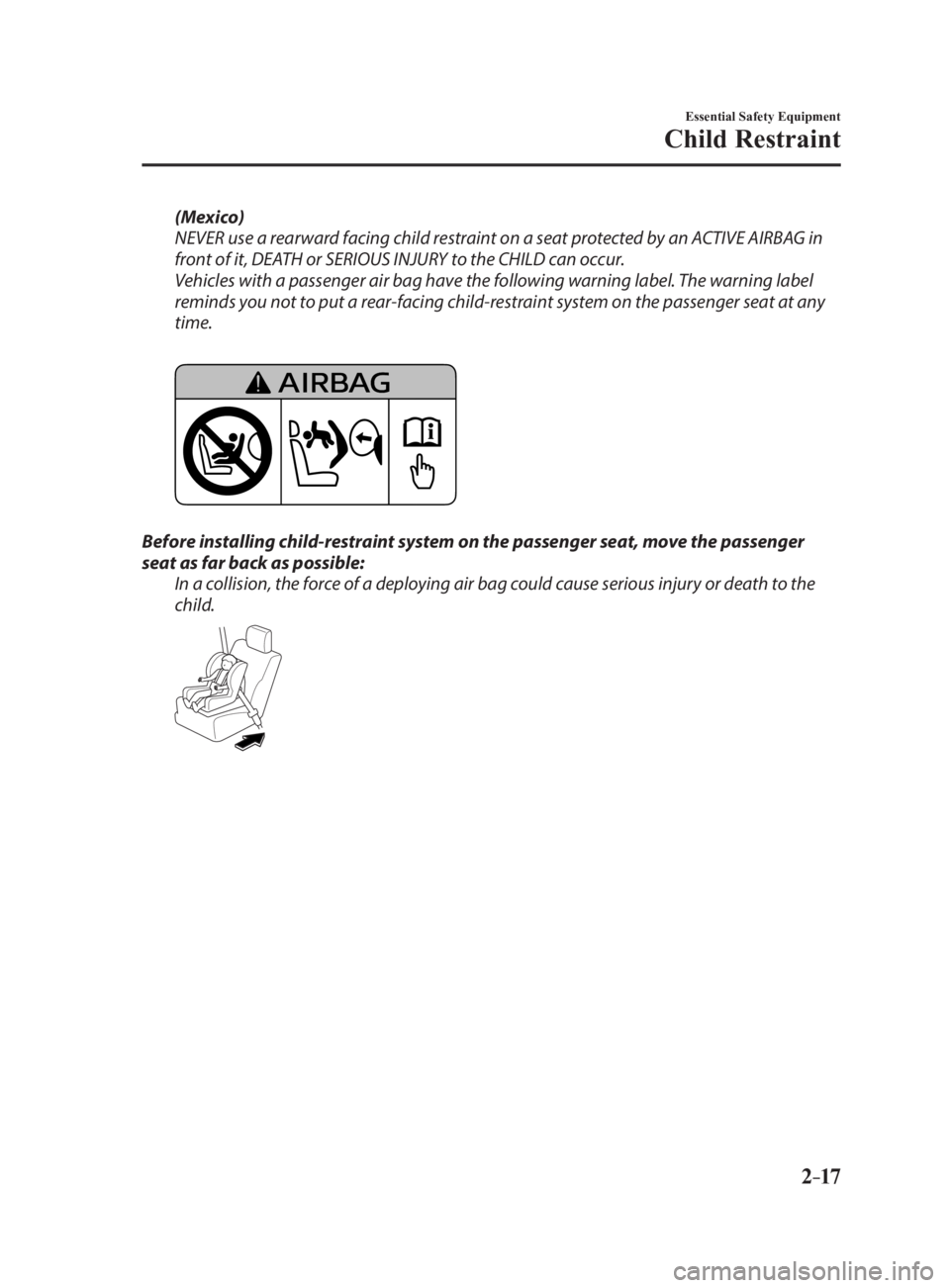
2 –17 Essential Safety Equipment
Child Restraint(Mexico)
NEVER use a rearward facing child restraint on a seat protected by an ACTIVE AIRBAG in
front of it, DEATH or SERIOUS INJURY to the CHILD can occur.
Vehicles with a passenger air bag have the following warning label. The warning label
reminds you not to put a rear-facing child-restraint system on the passenger seat at any
time.
Before installing child-restraint system on the passenger seat, move the passenger
seat as far back as possible:
In a collision, the force of a deploying air bag could cause serious injury or death to the
child.
MX-5_8FR4-EA-16J_Edition1.indb 17 2016/08/11 20:28:23
Page 32 of 568

2 –18 Essential Safety Equipment
Child Restraint Seating a child in a child-restraint system on the passenger seat is dangerous under
certain conditions (With Passenger Occupant Classification System):
Your vehicle is equipped with passenger occupant classification sensor. Even with the
passenger occupant classification sensor, if you must use the passenger seat to seat a
child, using a child-restraint system on the passenger seat under the following conditions
increases the danger of the passenger air bag deploying and could result in serious injury
or death to the child.
The passenger air bag deactivation indicator light does not illuminate when seating a
child in the child-restraint system.
Luggage or other items are placed on the seat with the child in the child-restraint
system.
The seat is washed.
Liquids are spilled on the seat.
The passenger seat is moved backward, pushing into luggage or other items placed
behind it.
Luggage or other items are placed between the passenger seat and driver seat.
An electric device is put on the passenger's seat.
An additional electrical device, such as a seat warmer is installed to the surface of the
passenger seat.
Do not allow a child or anyone to lean over or against the side window of a vehicle with
side air bags:
It is dangerous to allow anyone to lean over or against the side window, the area of the
passenger seat from which the side air bags deploy, even if a child-restraint system is
used. The impact of inflation from a side air bag could cause serious injury or death to an
out of position child. Furthermore, leaning over or against the door could block the side
air bags and eliminate the advantages of supplemental protection. Because the side air
bag deploys from the outboard shoulder of the seat, do not allow the child to lean over or
against the side window, even if the child is seated in a child-restraint system.
Never use one seat belt on more than one person at a time:
Using one seat belt for more than one person at a time is dangerous. A seat belt used
in this way cannot spread the impact forces properly and the two passengers could
be crushed together and seriously injured or even killed. Never use one belt for more
than one person at a time and always operate the vehicle with each occupant properly
restrained.
Always use a child-restraint system designed for use without a tether or the LATCH
lower anchor:
Using a child-restraint system that requires a tether or the LATCH lower anchor is
dangerous. Your Mazda does not have a child-restraint tether or the LATCH lower anchor.
The child-restraint system cannot be properly secured. In a collision, it could move and
injure other occupants as well as result in serious injuries or death to the child.
MX-5_8FR4-EA-16J_Edition1.indb 18 2016/08/11 20:28:23
Page 33 of 568
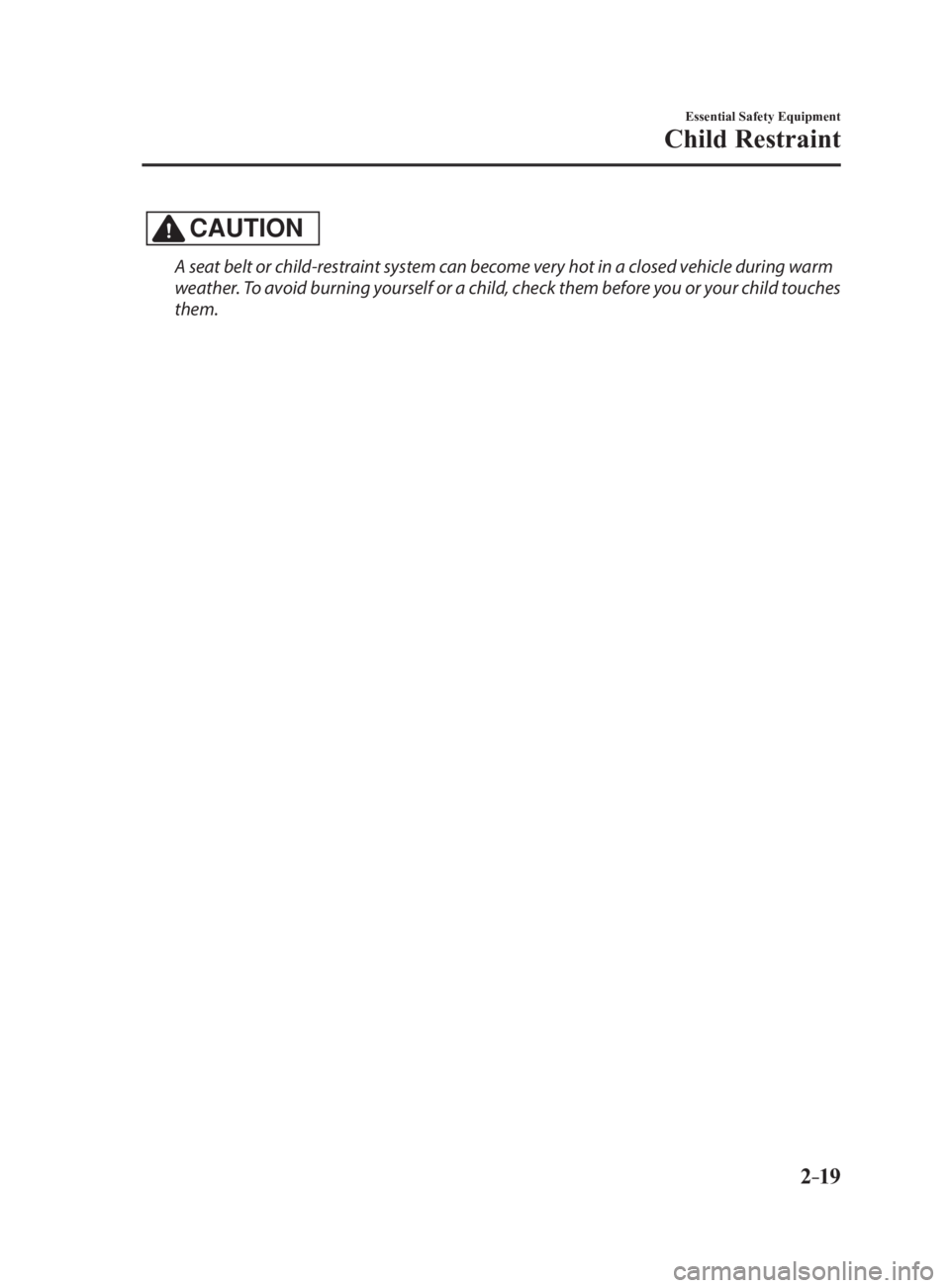
2 –19 Essential Safety Equipment
Child Restraint
CAUTION A seat belt or child-restraint system can become very hot in a closed vehicle during warm
weather. To avoid burning yourself or a child, check them before you or your child touches
them.
MX-5_8FR4-EA-16J_Edition1.indb 19 2016/08/11 20:28:24
Page 34 of 568
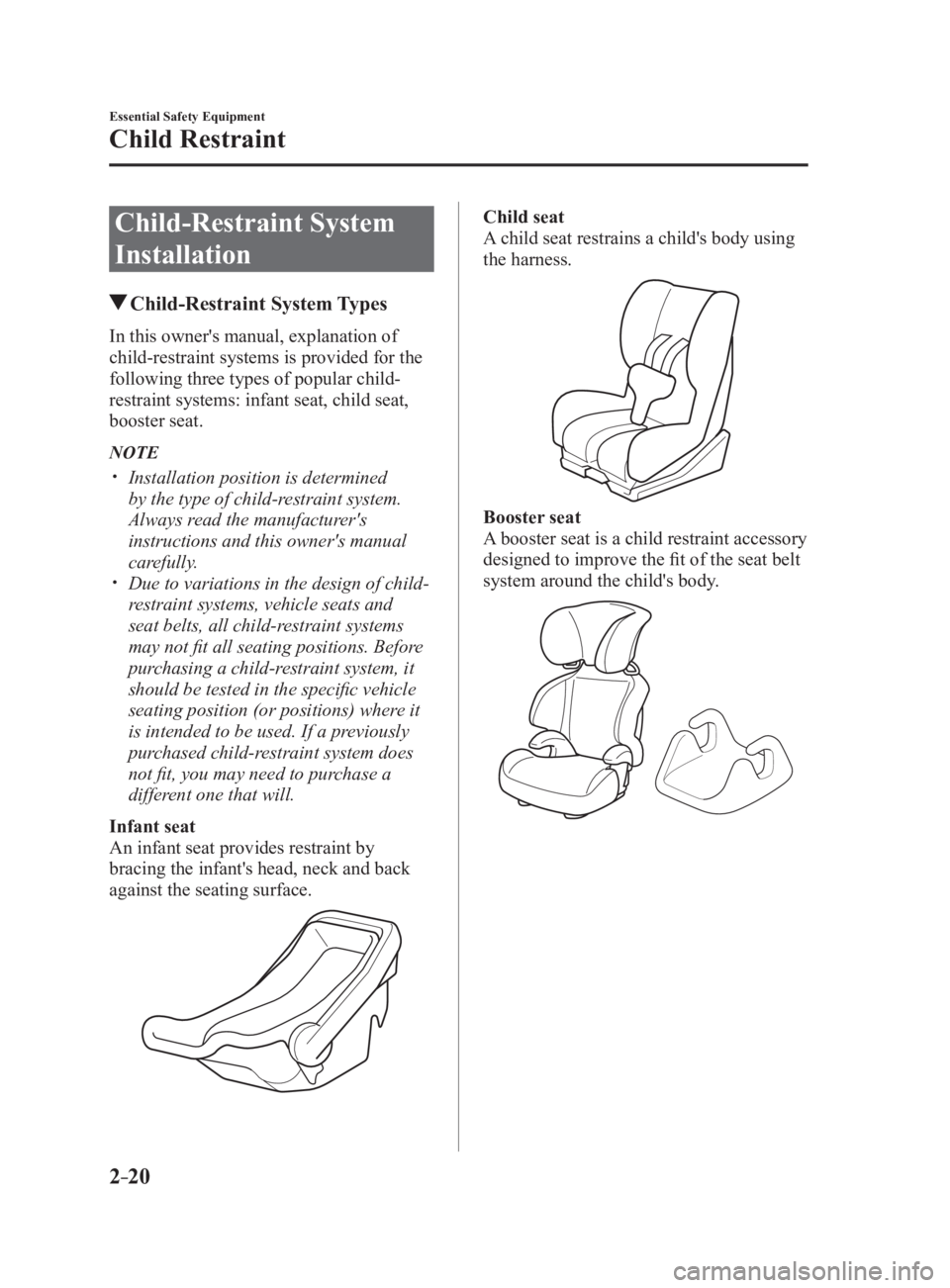
2 –20 Essential Safety Equipment
Child Restraint
Child-Restraint System
Installation Child-Restraint System TypesIn this owner's manual, explanation of
child-restraint systems is provided for the
following three types of popular child-
restraint systems: infant seat, child seat,
booster seat.
NOTE
Installation position is determined
by the type of child-restraint system.
Always read the manufacturer's
instructions and this owner's manual
carefully.
Due to variations in the design of child-
restraint systems, vehicle seats and
seat belts, all child-restraint systems
may not fit all seating positions. Before
purchasing a child-restraint system, it
should be tested in the specific vehicle
seating position (or positions) where it
is intended to be used. If a previously
purchased child-restraint system does
not fit, you may need to purchase a
different one that will.
Infant seat
An infant seat provides restraint by
bracing the infant's head, neck and back
against the seating surface. Child seat
A child seat restrains a child's body using
the harness.
Booster seat
A booster seat is a child restraint accessory
designed to improve the fit of the seat belt
system around the child's body.
MX-5_8FR4-EA-16J_Edition1.indb 20 2016/08/11 20:28:24
Page 35 of 568
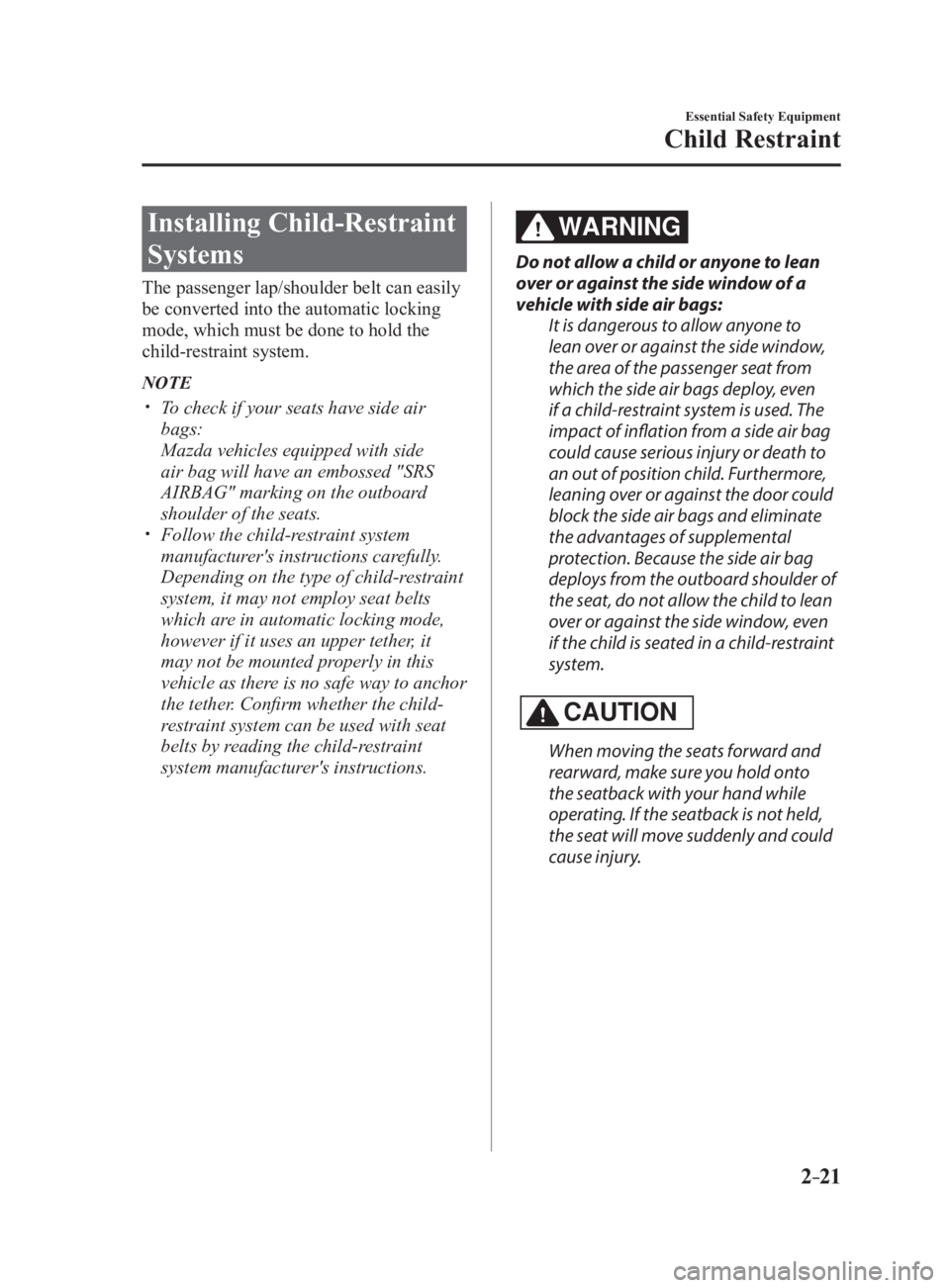
2 –21 Essential Safety Equipment
Child Restraint
Installing Child-Restraint
Systems The passenger lap/shoulder belt can easily
be converted into the automatic locking
mode, which must be done to hold the
child-restraint system.
NOTE
To check if your seats have side air
bags:
Mazda vehicles equipped with side
air bag will have an embossed "SRS
AIRBAG" marking on the outboard
shoulder of the seats.
Follow the child-restraint system
manufacturer's instructions carefully.
Depending on the type of child-restraint
system, it may not employ seat belts
which are in automatic locking mode,
however if it uses an upper tether, it
may not be mounted properly in this
vehicle as there is no safe way to anchor
the tether. Confirm whether the child-
restraint system can be used with seat
belts by reading the child-restraint
system manufacturer's instructions. WARNING Do not allow a child or anyone to lean
over or against the side window of a
vehicle with side air bags:
It is dangerous to allow anyone to
lean over or against the side window,
the area of the passenger seat from
which the side air bags deploy, even
if a child-restraint system is used. The
impact of inflation from a side air bag
could cause serious injury or death to
an out of position child. Furthermore,
leaning over or against the door could
block the side air bags and eliminate
the advantages of supplemental
protection. Because the side air bag
deploys from the outboard shoulder of
the seat, do not allow the child to lean
over or against the side window, even
if the child is seated in a child-restraint
system.
CAUTION When moving the seats forward and
rearward, make sure you hold onto
the seatback with your hand while
operating. If the seatback is not held,
the seat will move suddenly and could
cause injury.
MX-5_8FR4-EA-16J_Edition1.indb 21 2016/08/11 20:28:24
Page 36 of 568
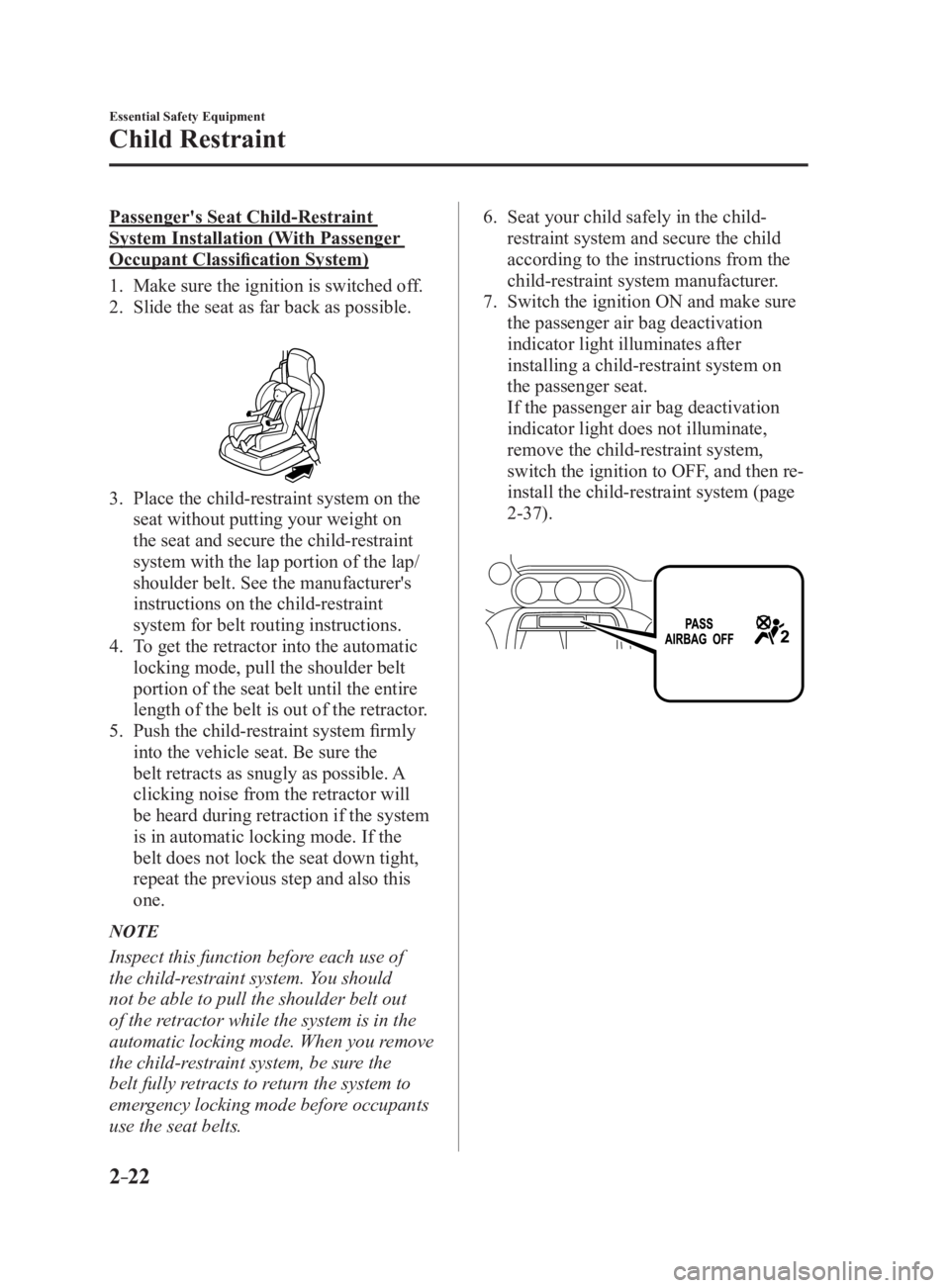
2 –22 Essential Safety Equipment
Child Restraint Passenger's Seat Child-Restraint
System Installation (With Passenger
Occupant Classification System)
1. Make sure the ignition is switched off.
2. Slide the seat as far back as possible.
3. Place the child-restraint system on the
seat without putting your weight on
the seat and secure the child-restraint
system with the lap portion of the lap/
shoulder belt. See the manufacturer's
instructions on the child-restraint
system for belt routing instructions.
4. To get the retractor into the automatic
locking mode, pull the shoulder belt
portion of the seat belt until the entire
length of the belt is out of the retractor.
5. Push the child-restraint system firmly
into the vehicle seat. Be sure the
belt retracts as snugly as possible. A
clicking noise from the retractor will
be heard during retraction if the system
is in automatic locking mode. If the
belt does not lock the seat down tight,
repeat the previous step and also this
one.
NOTE
Inspect this function before each use of
the child-restraint system. You should
not be able to pull the shoulder belt out
of the retractor while the system is in the
automatic locking mode. When you remove
the child-restraint system, be sure the
belt fully retracts to return the system to
emergency locking mode before occupants
use the seat belts. 6. Seat your child safely in the child-
restraint system and secure the child
according to the instructions from the
child-restraint system manufacturer.
7. Switch the ignition ON and make sure
the passenger air bag deactivation
indicator light illuminates after
installing a child-restraint system on
the passenger seat.
If the passenger air bag deactivation
indicator light does not illuminate,
remove the child-restraint system,
switch the ignition to OFF, and then re-
install the child-restraint system (page
2-37 ).
MX-5_8FR4-EA-16J_Edition1.indb 22 2016/08/11 20:28:24
Page 37 of 568

2 –23 Essential Safety Equipment
Child Restraint
WARNING Do not seat a child in a child-restraint
system on the passenger seat if the
passenger air bag deactivation
indicator light does not illuminate (With
Passenger Occupant Classification
System):
Seating a child in a child-restraint
system installed on the passenger
seat with the passenger air bag
deactivation indicator light not
illuminated is dangerous. If this
indicator light does not illuminate,
this means that the passenger front
and side air bags, and seat belt
pretensioner are ready for deployment.
If an accident were to deploy an air
bag, a child in a child-restraint system
sitting in the passenger seat could
be seriously injured or killed. If the
indicator light does not illuminate
after seating a child in a child-restraint
system on the passenger seat consult
an Authorized Mazda Dealer as soon
as possible.
MX-5_8FR4-EA-16J_Edition1.indb 23 2016/08/11 20:28:24
Page 38 of 568

2 –24 Essential Safety Equipment
SRS Air Bags
Supplemental Restraint System (SRS) Precautions The front and side supplemental restraint systems (SRS) include different types of air bags.
Please verify which kinds of air bags are equipped on your vehicle by locating the
“SRS AIRBAG” location indicators. These indicators are visible in the area where the air
bags are installed.
The air bags are installed in the following locations:
The steering wheel hub (driver air bag)
The passenger dashboard (passenger air bag)
The outboard sides of the seatbacks (side air bags)
The air bag supplemental restraint systems are designed to provide supplemental protection
in certain situations so seat belts are always important in the following ways:
Without seat belt usage, the air bags cannot provide adequate protection during an accident.
Seat belt usage is necessary to:
Keep the occupant from being thrown into an inflating air bag.
Reduce the possibility of injuries during an accident that is n ot designed for air bag
inflation, such as roll-over or rear impact.
Reduce the possibility of injuries in frontal, near frontal or side collisions that are not
severe enough to activate the air bags.
Reduce the possibility of being thrown from your vehicle.
Reduce the possibility of injuries to lower body and legs durin g an accident because the
air bags provide no protection to these parts of the body.
Hold the driver in a position which allows better control of the vehicle.
If your vehicle is also equipped with a passenger occupant classification system, refer
to the Passenger Occupant Classification System (page 2-37 ) for details.
If your vehicle is equipped with a passenger occupant classifica tion system, the passenger
air bag deactivation indicator light illuminates for a specified time after the ignition is
switched ON.
MX-5_8FR4-EA-16J_Edition1.indb 24 2016/08/11 20:28:24
Page 39 of 568

2 –25 Essential Safety Equipment
SRS Air BagsSmall children must be protected by a child-restraint system as stipulated by law in every
state and province. In certain states and provinces, larger children must use a child-restraint
system (page 2-15 ).
Carefully consider which child-restraint system is necessary for your child and follow
the installation directions in this Owner's Manual as well as the child-restraint system
manufacturer's instructions.
Do not use a child-restraint system which employs an upper tether because there is no
appropriate means to anchor the tether.
WARNING Seat belts must be worn in air bag equipped vehicles:
Depending only on the air bags for protection during an accident is dangerous. Alone, air
bags may not prevent serious injuries. The appropriate air bags can be expected to inflate
only in the first accident, such as frontal, near frontal or side collisions that are at least
moderate. Vehicle occupants should always wear seat belts.
Always make sure the passenger air bag deactivation indicator light is illuminated
when using a child-restraint system (With Passenger Occupant Classification System):
Seating a child in a child-restraint system that is installed on the passenger seat with the
passenger air bag deactivation indicator light not illuminated is extremely dangerous. In
an accident, an air bag could inflate and cause serious injuries or even death to the child
seated in the child-restraint system. Always make sure the passenger air bag deactivation
indicator light is illuminated.
Refer to Occupant Classification System on page 2-37 .
Do not sit too close to the driver and passenger air bags:
Sitting too close to the driver and passenger air bag modules or placing hands or feet on
them is extremely dangerous. The driver and passenger air bags inflate with great force
and speed. Serious injuries could occur if someone is too close. The driver should always
hold onto only the rim of the steering wheel. The passenger should keep both feet on
the floor. Seat occupants should adjust their seats as far back as possible and always sit
upright against the seatbacks with seat belts worn properly.
Do not sit too close to a door or lean against doors in vehicles with side air bags:
Sitting too close to the side air bag modules or placing hands on them is extremely
dangerous. A side air bag inflates with great force and speed directly out of the outboard
shoulder of the seat and expands along the door on the side the car is hit. Serious injury
could occur if someone is sitting too close to the door or leaning against a window in the
seats. Furthermore, sleeping up against the door or hanging out the driver-side window
while driving could block the side air bag and eliminate the advantages of supplemental
protection. Give the side air bags room to work by sitting in the center of the seat while
the vehicle is moving with seat belts worn properly.
MX-5_8FR4-EA-16J_Edition1.indb 25 2016/08/11 20:28:24
Page 40 of 568

2 –26 Essential Safety Equipment
SRS Air Bags Sit in the center of the seat and wear seat belts properly:
Sitting too close to the side air bag modules or placing hands on them, or sleeping up
against the door or hanging out the windows is extremely dangerous. The side air bags
inflate with great force and speed directly expanding along the door on the side the car is
hit. Serious injury could occur if someone is sitting too close to the door. Give the side air
bags room to work by sitting in the center of the seat while the vehicle is moving with seat
belts worn properly.
Do not attach objects on or around the area where driver and passenger air bags
deploy:
Attaching an object to the driver and passenger air bag modules or placing something in
front of them is dangerous. In an accident, an object could interfere with air bag inflation
and injure the occupants.
Do not attach objects on or around the area where a side air bag deploys:
Attaching objects to the seat in such a way as to cover the outboard side of the seat in any
way is dangerous. In an accident the object could interfere with the side air bag, which
inflates from the outboard side of the seats, impeding the added protection of the side air
bag system or redirecting the air bag in a way that is dangerous. Furthermore, the bag
could be cut open releasing the gas.
Do not hang net bags, map pouches or backpacks with side straps on the seats. Never use
seat covers on the seats. Always keep the side air bag modules in your seats free to deploy
in the event of a side collision.
Do not touch the components of the supplemental restraint system after the air bags
have inflated:
Touching the components of the supplemental restraint system after the air bags have
inflated is dangerous. Immediately after inflation, they are very hot. You could get burned.
Never install any front-end equipment to your vehicle:
Installation of front-end equipment, such as frontal protection bar (kangaroo bar, bull
bar, push bar, or other similar devices), snowplow, or winches, is dangerous. The air bag
crash sensor system could be affected. This could cause air bags to inflate unexpectedly,
or it could prevent the air bags from inflating during an accident. Occupants could be
seriously injured.
Do not modify the suspension:
Modifying the vehicle suspension is dangerous. If the vehicle's height or the suspension is
modified, the vehicle will be unable to accurately detect a collision resulting in incorrect
or unexpected air bag deployment and the possibility of serious injuries.
MX-5_8FR4-EA-16J_Edition1.indb 26 2016/08/11 20:28:25